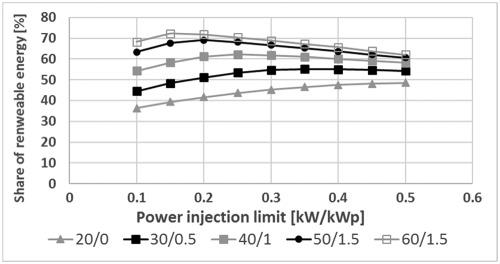当前位置:
X-MOL 学术
›
Prog. Photovoltaics
›
论文详情
Our official English website, www.x-mol.net, welcomes your
feedback! (Note: you will need to create a separate account there.)
Managing PV power injection and storage, enabling a larger direct consumption of renewable energy: A case study for the Belgian electricity system
Progress in Photovoltaics ( IF 8.0 ) Pub Date : 2018-10-31 , DOI: 10.1002/pip.3084 Marc Meuris 1, 2, 3 , Pieter Lodewijks 1, 4 , Raf Ponnette 1, 4 , Frank Meinke‐Hubeny 1, 4 , Pieter Valkering 1, 4 , Ronnie Belmans 1, 5 , Jef Poortmans 1, 3, 5, 6
Progress in Photovoltaics ( IF 8.0 ) Pub Date : 2018-10-31 , DOI: 10.1002/pip.3084 Marc Meuris 1, 2, 3 , Pieter Lodewijks 1, 4 , Raf Ponnette 1, 4 , Frank Meinke‐Hubeny 1, 4 , Pieter Valkering 1, 4 , Ronnie Belmans 1, 5 , Jef Poortmans 1, 3, 5, 6
Affiliation

|
An overall model and scenario for increasing the share of renewable electricity consumption in the Belgium grid is proposed by simulating different PV and home battery capacities. The model is balancing the electricity generation of these renewable sources on an hourly basis with the historical consumption profiles of 2014, 2015, and 2016 to estimate how much renewable energy can be consumed directly. The model considers the problem of potential overloads on the low voltage grid, by limiting with curtailment the total PV injection on the low voltage grid to a level that can be currently sustained. A simple algorithm for grid injection limitation of this curtailment during daytime and nighttime is proposed, with and without the use of batteries. The share of renewable electricity consumption is calculated, investigating the impact of battery sizing and different levels for the power injection limit. Above a certain level, additional battery capacity has no effect. With increasing total PV deployment, the optimal power injection limit is reduced. A realistic and effective deployment scenario for renewable electricity from wind and PV is developed (up to 9 GW wind and 50 GWp PV for the Belgian case). It is possible to reach a share of consumed renewable electricity of almost 50% with a curtailment of 9% without the use of batteries. With higher PV deployment and a minimal amount of home battery capacity (1.5 kWh/kWp), a 70% share of consumed renewable energy is realized, with a curtailment of less than 20%.
中文翻译:

管理光伏发电的注入和存储,使更多的可再生能源直接消费:比利时电力系统的案例研究
通过模拟不同的光伏和家用电池容量,提出了用于提高比利时电网中可再生电力消耗份额的总体模型和方案。该模型将每小时可再生能源的发电量与2014年,2015年和2016年的历史消费情况进行平衡,以估算可直接消耗多少可再生能源。该模型通过将低压电网上的总PV注入量限制在当前可以维持的水平,从而考虑了低压电网上潜在的过载问题。提出了一种在白天和晚上使用或不使用电池的情况下限制这种限制的网格注入的简单算法。计算可再生用电量的份额,调查电池尺寸和不同级别的功率注入限制的影响。超过一定水平,额外的电池容量将无效。随着总PV部署量的增加,最佳功率注入极限会降低。已开发出一种切实可行的风能和光伏可再生电力部署方案(比利时情况下可达到9 GW风能和50 GWp PV)。在不使用电池的情况下,有可能达到消耗的可再生电力份额的近50%,减少了9%。随着更高的PV部署和最少的家用电池容量(1.5 kWh / kWp),可实现70%的可再生能源消耗份额,而减少的比例不到20%。随着总PV部署量的增加,最佳功率注入极限会降低。已开发出一种切实可行的风能和光伏可再生电力部署方案(比利时情况下可达到9 GW风能和50 GWp PV)。在不使用电池的情况下,有可能达到消耗的可再生电力份额的近50%,减少了9%。随着更高的PV部署和最少的家用电池容量(1.5 kWh / kWp),可实现70%的可再生能源消耗份额,而减少的比例不到20%。随着总PV部署量的增加,最佳功率注入极限会降低。已开发出一种切实可行的风能和光伏可再生电力部署方案(比利时情况下可达到9 GW风能和50 GWp PV)。在不使用电池的情况下,有可能达到消耗的可再生电力份额的近50%,减少了9%。随着更高的PV部署和最少的家用电池容量(1.5 kWh / kWp),可实现70%的可再生能源消耗份额,而减少的比例不到20%。在不使用电池的情况下,有可能达到消耗的可再生电力份额的近50%,减少了9%。随着更高的PV部署和最少的家用电池容量(1.5 kWh / kWp),可实现70%的可再生能源消耗份额,而减少的比例不到20%。在不使用电池的情况下,有可能达到消耗的可再生电力份额的近50%,减少了9%。随着更高的PV部署和最少的家用电池容量(1.5 kWh / kWp),可实现70%的可再生能源消耗份额,而减少的比例不到20%。
更新日期:2018-10-31
中文翻译:

管理光伏发电的注入和存储,使更多的可再生能源直接消费:比利时电力系统的案例研究
通过模拟不同的光伏和家用电池容量,提出了用于提高比利时电网中可再生电力消耗份额的总体模型和方案。该模型将每小时可再生能源的发电量与2014年,2015年和2016年的历史消费情况进行平衡,以估算可直接消耗多少可再生能源。该模型通过将低压电网上的总PV注入量限制在当前可以维持的水平,从而考虑了低压电网上潜在的过载问题。提出了一种在白天和晚上使用或不使用电池的情况下限制这种限制的网格注入的简单算法。计算可再生用电量的份额,调查电池尺寸和不同级别的功率注入限制的影响。超过一定水平,额外的电池容量将无效。随着总PV部署量的增加,最佳功率注入极限会降低。已开发出一种切实可行的风能和光伏可再生电力部署方案(比利时情况下可达到9 GW风能和50 GWp PV)。在不使用电池的情况下,有可能达到消耗的可再生电力份额的近50%,减少了9%。随着更高的PV部署和最少的家用电池容量(1.5 kWh / kWp),可实现70%的可再生能源消耗份额,而减少的比例不到20%。随着总PV部署量的增加,最佳功率注入极限会降低。已开发出一种切实可行的风能和光伏可再生电力部署方案(比利时情况下可达到9 GW风能和50 GWp PV)。在不使用电池的情况下,有可能达到消耗的可再生电力份额的近50%,减少了9%。随着更高的PV部署和最少的家用电池容量(1.5 kWh / kWp),可实现70%的可再生能源消耗份额,而减少的比例不到20%。随着总PV部署量的增加,最佳功率注入极限会降低。已开发出一种切实可行的风能和光伏可再生电力部署方案(比利时情况下可达到9 GW风能和50 GWp PV)。在不使用电池的情况下,有可能达到消耗的可再生电力份额的近50%,减少了9%。随着更高的PV部署和最少的家用电池容量(1.5 kWh / kWp),可实现70%的可再生能源消耗份额,而减少的比例不到20%。在不使用电池的情况下,有可能达到消耗的可再生电力份额的近50%,减少了9%。随着更高的PV部署和最少的家用电池容量(1.5 kWh / kWp),可实现70%的可再生能源消耗份额,而减少的比例不到20%。在不使用电池的情况下,有可能达到消耗的可再生电力份额的近50%,减少了9%。随着更高的PV部署和最少的家用电池容量(1.5 kWh / kWp),可实现70%的可再生能源消耗份额,而减少的比例不到20%。











































 京公网安备 11010802027423号
京公网安备 11010802027423号